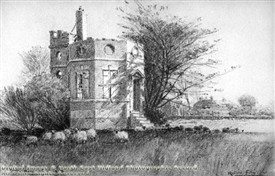Radford

Radford Folly
www.picturethepast.org.uk
A small place with big connections - Alan Sillitoe, John Players Tobacco and Raleigh Bicycles
In his Old Nottingham suburbs: then and now (1914), the author Robert Mellors says that Radford ‘probably derived its name of the "red ford" from the Mottled Bed Sandstone in the high cliff … which terminated where the Alfreton Road crossed the Leen by a ford’…
The manor of Radeford is mentioned in the Domesday Book (1086). At a later date ownership of the village passed to Lenton Priory.
The original village was situated around St Peter’s parish church - on what is now Churchfield Lane. The medieval church fell into disrepair and was demolished; a new one was built in 1812 and a chancel added in 1872.
In 1864, another Anglican church, All Soul’s, was built on Raleigh Street, Radford.
In the early years the area between St Peter’s Church to the top of Derby Road was open land with fields and gardens. From 1794 onwards, the area began to be developed and by the mid 19th Century it was covered in cramped streets and yards, with poor quality housing.
A famous landmark in old Radford was the Radford Folly situated at what is now close to the junction of New Road and Maun Avenue. It was part of a pleasure garden were laid out by William Elliott in 1780. It became a famous tea garden. With the increased industrialisation of the area the Folly and gardens became derelict - the last remnants of the Folly were demolished in 1957.
Some of the industries which have made Nottingham famous were situated in Radford - most notably John Players tobacco factory and Raleigh Cycles.
Nottingham-born author Alan Sillitoe’s family lived on Salisbury Street in Radford and his novel Saturday Night and Sunday Morning (1958) was set in Radford; the 1960 film of the novel features many well-known local places, such as the White Horse pub on Ilkeston Road.
Like many other areas of the City, Radford has undergone a number of major redevelopments over the past 50 years, with acres of original housing demolished to be replaced with new buildings.
This page was added by
H W on 30/10/2012.